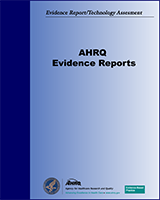NCBI Bookshelf. A service of the National Library of Medicine, National Institutes of Health.
This publication is provided for historical reference only and the information may be out of date.
Structured Abstract
Objectives:
In 1996, an estimated 74,116 patients developed endstage renal disease (ESRD); most had anemia as a result of their chronic renal failure (CRF). Epoetin offers patients with anemia of CRF the potential to increase hematocrit (Hct) to a level considered normal for a healthy individual; yet the benefits and risks of such a management strategy have not been well established.
This systematic review seeks primarily to compare outcomes of maintaining a target Hct above 36 percent with outcomes of maintaining a target Hct in the 33 to <36 percent range in patients with CRF. The published clinical trial evidence that addresses the comparison of primary interest for this systematic review was quite limited. To maximize the comprehensiveness of this report, we decided, in consultation with advisory experts, also to synthesize and analyze results of studies reported only in abstract form; studies using any form of controlled design; and studies reporting intermediate outcomes known or thought, to predict health outcomes. Therefore, this report includes associational studies as well as interventional studies -- studies in which the Hct in the control group was maintained in the 30 to <33 percent range as well as those studies in which the Hct in the control group was maintained in the 33 to <36 percent range.
The report addresses: (1) adult CRF patients and (2) subpopulations of interest (with or without CRF) who have any one of seven predefined clinical characteristics thought to warrant Hct above 36 percent. We also attempted to review the outcomes of maintaining Hct above 30 percent as compared with maintaining Hct in the 27 to 30 range in pediatric CRF patients; however, no studies met the study eligibility criteria.
Search Strategy:
MEDLINE and EMBASE databases were searched from 1985 to December 1998 and Current Contents to October 30, 1999. Two search strategies both included the terms: ("erythropoietin," "epoetin alfa," "epoetin," "Epogen," "Procrit," or "epo") and ("anemia/drug therapy," "anemia/therapy," or "anemia/diet therapy"). The first strategy also required the term "kidney failure," whereas the second strategy required at least one of the following terms: "heart failure," "congestive disease," "coronary disease," "arterial occlusive disease," cerebrovascular disease," "lung diseases, obstructive," "altitude," or "adolescent." The search results were limited to human subjects and English-language literature.
Selection Criteria:
The study team included all controlled intervention studies and cross-sectional analyses with at least 10 patients per group and reported outcomes related to the Hct range comparisons of interest.
Data Collection and Analysis:
The systematic review prospectively defined a protocol conducted by two independent reviewers, with disagreements resolved by consensus. A set of predefined data elements was abstracted from included studies. The quality of studies was assessed qualitatively. Descriptive results were reported as the body of evidence was not suited for quantitative analysis.
Main Results:
The evidence is not sufficient to compare the outcomes of target Hct above 36 compared with 33 to <36 percent in adults with CRF. More evidence is available to compare the outcomes of target Hct above 36 compared with 30 to 36 percent. However, the evidence does not provide strong or consistent support that maintaining target Hct above 36 percent is beneficial.
In hemodialysis patients with documented ischemic cardiac disease or congestive heart failure, a randomized controlled trial (n=1,233) was halted because of increased mortality and because it was determined that a treatment benefit in the primary endpoint could not be demonstrated even if the trial was completed. No other studies reported on subpopulations of CRF patients with clinical characteristics thought to warrant target Hct above 36 percent.
Conclusions:
The published literature does not provide strong or consistent support that maintaining Hct above 36 percent is more beneficial to patients with CRF than maintaining Hct in the target range of 33 to 36 percent recommended by the National Kidney Foundation's Dialysis Outcomes Quality Initiatives. Limited data on physiologic measures suggest a possible benefit for selected patients when Hct is maintained above 36 percent. However, the potential for benefit should be tested in well-designed intervention studies.
Contents
Prepared for: Agency for Healthcare Research and Quality, U.S. Department of Health and Human Services.1 Contract No. 290-97-0015. Prepared by: Blue Cross and Blue Shield Association Technology Evaluation Center.
Suggested citation:
Flamm CR, Aronson N, Bohn R, et al. Use of Epoetin for Anemia in Chronic Renal Failure. Evidence Report/Technology Assessment No. 29 (Prepared by the Blue Cross and Blue Shield Association Technology Evaluation Center under Contract No. 290-97-0015). AHRQ Publication No. 01-E016. Rockville (MD) Agency for Healthcare Research and Quality. August 2001.
On December 6, 1999, under Public Law 106-129, the Agency for Health Care Policy and Research (AHCPR) was reauthorized and renamed the Agency for Healthcare Research and Quality (AHRQ). The law authorizes AHRQ to continue its research on the cost, quality, and outcomes of health care and expands its role to improve patient safety and address medical errors.
This report may be used, in whole or in part, as the basis for development of clinical practice guidelines and other quality enhancement tools, or a basis for reimbursement and coverage policies. AHRQ or U.S. Department of Health and Human Services endorsement of such derivative products may not be stated or implied.
The authors of this report are responsible for its content. Statements in the report should not be construed as endorsement by the Agency for Healthcare Research and Quality or the U.S. Department of Health and Human Services of a particular drug, device, test, treatment, or other clinical service.
- 1
2101 East Jefferson Street, Rockville, MD 20852.www
.ahrq.gov
